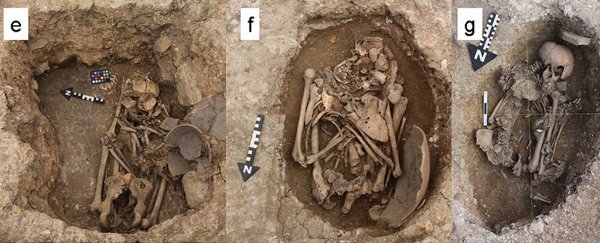Skeletal remains uncovered from a ritual platform in the Peruvian highlands at the site now known as Pacopampa show that people buried there suffered violent injuries, likely as part of ceremonial rituals, according to an archaeological study published earlier this month.
The scientists behind the discovery wrote that it looks like individuals suffered ceremonial blows to the head that fractured their skulls - perhaps willingly - though those blows likely didn't kill them.
"Given the archaeological context (the remains were recovered from sites of ceremonial practices), as well as the equal distribution of trauma among both sexes and a lack of defensive architecture, it is plausible that rituals, rather than organised warfare or raids, caused most of the exhibited trauma," the authors wrote.
The question that remains is why.
One of the ways that present-day archaeologists try to understand ancient cultures is by looking for signs of violence. Knowing how people were injured or killed reveals conflict with other societies as well as religious and societal behaviour.
 Nagaoka et al, PLOS One (2017)
Nagaoka et al, PLOS One (2017)
Researchers have been able to learn much about the early civilisations that populated the Andes by studying the violence that occurred there.
In the remains of people from certain ancient Peruvian civilisations, like the Chinchorro (who lived near the coast from 7,000-1,600 BCE), signs of violence on skeletal remains seem to be the result of conflict.
Conflict-related trauma tends to be much more common in men than women. It also tends to be clustered on the left side of the head, and individuals may have fractured forearms associated with attempts to block weapons.
There are signs of human sacrifice dating back as far as 5,000 BCE on the coasts of Peru.
In the Central Andes, archaeologists knew that construction of public architecture indicating signs of organised societies began as far back as 3,000 BCE. But there has been less evidence of violence found to help shed light on behaviour.
These discoveries at Pacopampa provide new data.
 Nagaoka et al, PLOS One (2017)
Nagaoka et al, PLOS One (2017)
Excavations at Pacopampa began in 1939 and the researchers behind this study have been examining the site for their present research since 2005.
From 2005 to 2015, they discovered the remains of 104 people, 66 adults and 38 children, which date back to time periods known as the Middle (1200-800 BCE) and Late (800-500 BCE) Formative Periods.
Seven of the adult individuals, shown in the photo collage above, were all recovered from the same ceremonial platform of the site and showed signs of trauma to the head, limbs, and elbows.
Most of the injuries found in these individuals were to the skull. These sorts of injuries "suggest intention and repeated blows to have been the cause, rather than accidents," the authors wrote.
There were signs of healing as well, which implies that individuals didn't necessarily die from these injuries, even if they were severe.
Researchers don't think conflict is what caused the skull trauma here. Pacopampa is a ceremonial and not a defensive site, and these bodies weren't found in living quarters, which would be expected if the individuals had been killed in raids.
Plus, there weren't defensive wounds on these bodies. The limb injuries were likely associated with falls throughout life.
 Nagaoka et al, PLOS One (2017)
Nagaoka et al, PLOS One (2017)
Because these particular individuals were buried in places connected to religious rituals, the researchers wrote that ceremonial activity is a likely explanation for their trauma.
As for the reason why, the researchers can only speculate. Social tension related to food resource shortages led to social stratification and ritual violence in some early civilisations in the Central Andes, the authors wrote, but it's not clear that resource shortages affected Pacopampa at the times these individuals lived. Skeletal remains didn't show signs of nutritional shortages.
There are some indications that elite individuals in society identified with predatory animals with fierce characteristics, especially big cats like jaguars. The "controlled practice of violence" may have been a way for elites to show their dominance.
Over time, the injuries that these individuals suffered became more severe, potentially reflecting stratification between social classes.
Ritual violence did include human sacrifice in later eras, so researchers wrote the the ritual violence here may reflect the emergence of a hierarchical society.
In the early stages, ritual violence associated with the dominance of elites resulted in injury that grew more intense as time went on and that hierarchy was more clearly defined - eventually reaching the point where such rituals ended in death.
This article was originally published by Business Insider.
More from Business Insider:
